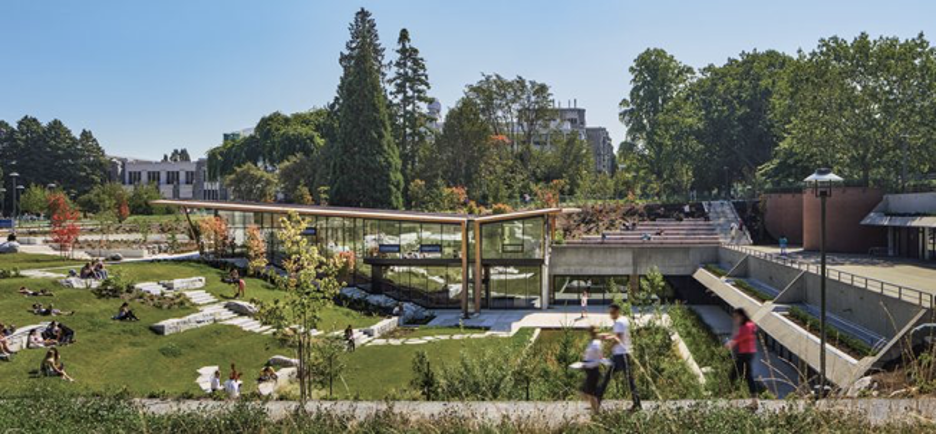
In recent times, it’s nearly impossible to miss the growing importance of being outside in parks, greenbelts and other open spaces (and the detriment if not, as seen with rising cases of ‘nature deficit disorder’). Elevating the value of nature is what drove the development of SITES. Embracing “ecosystem services” as its core framework, SITES is now driving sustainability efforts beyond the building. These services include but are not limited to filtering air pollutants, controlling flooding, maintaining drinkable water, regulating climate and improving human health and wellness. In order to be truly sustainable, resilient, healthy and equitable, we must design and weave meaningful outdoor spaces into our built environment.
SITES projects run the gamut from university campuses, federal courthouses and city parks, to corporate headquarters and mixed-use developments. The 186 currently registered and certified projects represent over 245 million gross square feet of sustainable and resilient outdoor space. They cover 12 countries and over 130 cities globally, and 38 U.S. States and Washington, DC. These projects set out to strike a balance between conservation, ecological restoration, community vitality and development.
Library Gardens, The University of British Columbia, Vancouver, Canada – PFS Studio

Most recently, we have certified the first SITES project in British Columbia (and the second in Canada). The University of British Columbia’s Library Gardens, as designed by PFS Studio, have revitalized their outdoor space to serve as a welcoming outdoor ‘living room’ that fosters social connection and mental restoration for students, faculty and visitors. The Indian Residential School History and Dialogue Centre is a key element in framing the garden and providing a First Nations presence at this historical center of campus. The plant material selected was coordinated with the Musqueam representatives. In addition to the outdoor spaces, views to the outdoors from the building are both key aspects of achieving SITES Credit 6.4: Support mental restoration.
Given its scale, history and cultural importance, the redesign of Library Gardens represents one of the most important public realm design initiatives by the university. According to Dean Gregory, the university Landscape Architect, “We know that natural and well-designed landscapes provide [ecosystem] services. They trap and filter rainwater, clean the air, control erosion, even help in pollination. If the SITES initiative can be used as a tool to help owners, designers, material suppliers, builders and groundskeepers to maximize these services, it’s something we as an academic institution need to champion. It’s just the right thing to do!”
AT&T Discovery District, Dallas, Texas

Located in downtown Dallas, Texas, the AT&T Discovery District was designed so the community could learn about the value and benefits of sustainable landscapes and discover the constantly evolving technology that the largest communications company in the world has to offer. Although there were no existing natural elements to conserve due to the project being on an urban infill site, the downtown location presents benefits in terms of community connectivity, walkability and public transportation. On-site bike lanes meander through the site and connect to the city’s bike network. The district also provides bike racks, emergency call boxes, free Wi-Fi and drinking fountains to support site users. In addition, the new landscape eliminates the need for potable water use for irrigation. This was accomplished through careful plant selection (mostly native vegetation) and utilizing a water reclamation system.
The Discovery District was designed to be a premier destination for employees and visitors alike. With the goal to be more inclusive, the project achieved innovation points by offering a hearing loop throughout the site exclusively for hard of hearing and deaf members of the community and visitors who wear telecoil hearing devices. This project also demonstrates a reinvestment to the local community -- over 80% of the construction subcontracts for the Plaza were awarded to local businesses.
Grant Park Gateway, Atlanta, Georgia

Photo courtesy of City of Atlanta, Department of Parks and Recreation
In 2018, the City of Atlanta addressed the need for a new parking garage near Zoo Atlanta and the Atlanta Beltline, responding to demands to reduce traffic congestion and improve overall safety in the area. The Grant Park Gateway project replaced the existing 8-acre parking lot with an aesthetically pleasing, semi-underground parking garage and accompanying 7.5 acre green roof. This new green space easily blends into the surrounding landscape. It includes a restaurant (also seeking LEED Silver certification), and other features such as a bandstand, a shaded plaza, terraced seating, a water feature and a pedestrian overpass among other design elements to improve human health and social activities.
Other sustainable features include a stormwater management system consisting of cisterns, infiltration trenches and a wet pond that manages the site’s 80th percentile stormwater event. By preserving healthy native plants, the project is also supporting habitat and protecting water storage and infiltration on site. Additionally, by using vegetation and reflective materials to reduce the heat island effect, the project has minimized negative effects on microclimate and human and wildlife habitat. The project is working toward becoming the first SITES, LEED and Parksmart certified project in the world, serving as an example for a “simple parking deck” project to achieve high design standards for not just the project itself, but for the surrounding site.
SITES is considered more than a certification system; it is an educational and leadership tool and a much needed voice at the table to activate positive change and enact a new vision for the future. Creating spaces that reconnect humans with nature will not only provide health and wellness benefits that come from that connection, but also foster community resilience, conserve resources, improve habitat for all and encourage environmental stewardship in present and future generations. It’s just the right thing to do.
